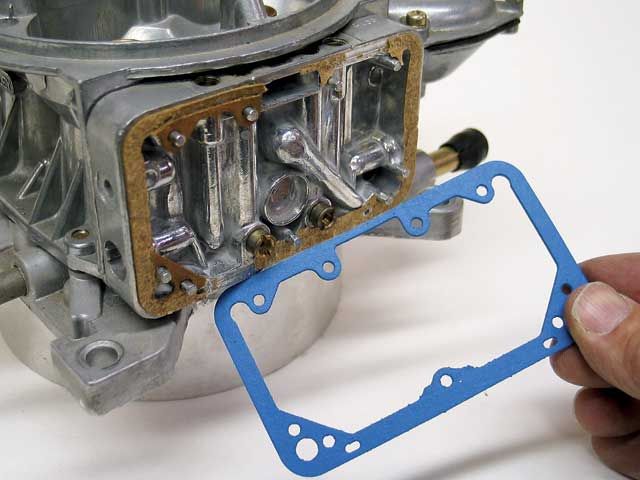
The hot tip in diets now is low-carb and Atkins friendly. But when itcomes to carburetors and power, we're all in favor of loading up oncarbs and tuning them to work their best. To this end, we thought we'dassemble a stack of carb-loading recipes, tech tips, small partsrecommendations, and other suggestions for Holley, Q-jet, Edelbrock, andDemon carburetors that you can use to transform that lump into a leanmean, carbureting machine.
Holley
Quick-Change Springs
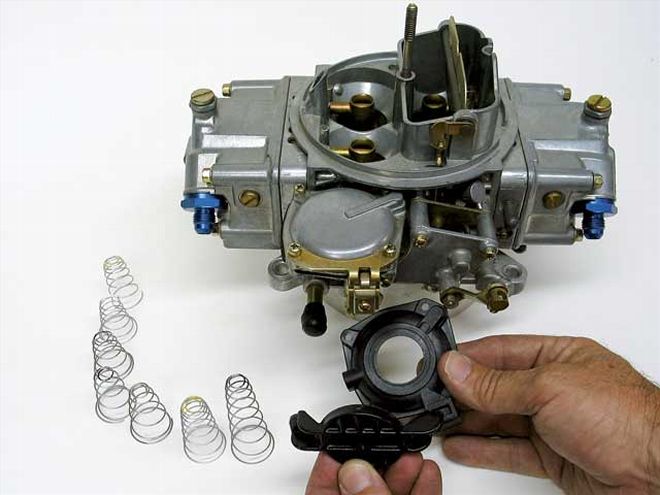
Many street Holleys like the PN 0-3310 750-cfm carbs come withvacuum-diaphragm controlled secondaries. If you've ever tried to changethe spring in these stock housings, you know how difficult it is to getthe rubber diaphragm lined up with the screw holes without tearing it.Holley now offers a quick-change diaphragm kit (PN 20-59, $12 throughSummit Racing) that eliminates the hassle with a sealed cover thatallows easy access to the diaphragm spring. You might also want toinclude a set of various diaphragm springs from kit PN 20-13 ($9), whichincludes seven springs from the lightest (white) to the heaviest(black).
Level Headed
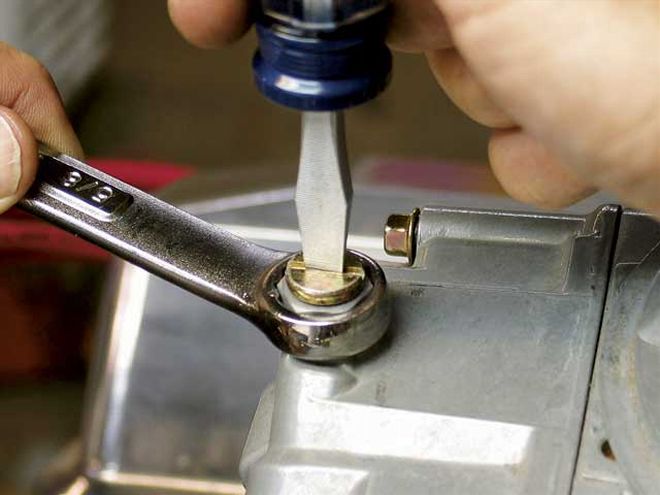
We always like to start with the basics, so one of the best places tobegin is with float level. Holleys are especially easy to adjust. Allyou need is a 5/8-inch wrench and a large flat-bladed screwdriver. Toadjust the level, remove the sight plug from the passenger side of thefloat bowl, or just look through the clear sight plug if your carb is soequipped. Loosen the lock screw on the top of the adjuster and turn theadjusting nut clockwise to lower the float level or counter-clockwise toraise the level. The proper float level at idle is when the fuel justtouches the bottom of the sight-plug hole. Raising the float level makesthe engine run richer; lowering the level leans the air/fuel ratioslightly.
PV Wives Tales
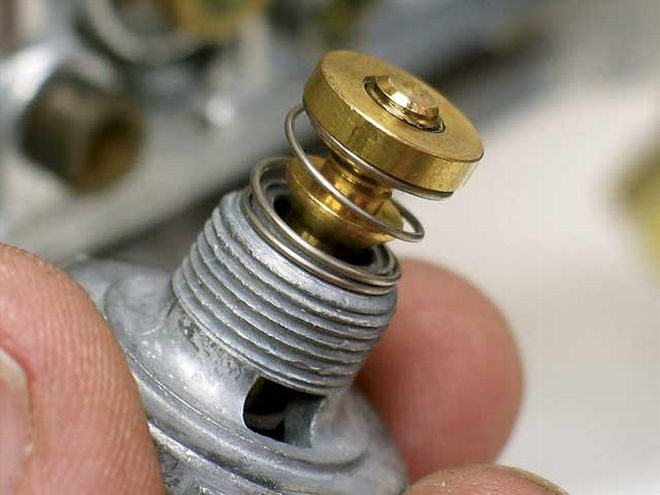
For years, magazines warned the world that running a power valve with anopening point below the idle vacuum would dump all kinds of fuel intothe engine at idle, foul plugs, and waste fuel. The whole idea of apower valve is to allow you to run leaner jets in the main circuit andstill add fuel when load increases. The truth is that the power-valvecircuit is completely separate from the idle circuit, so if your engineidles at 7 inches of manifold vacuum and the power valve opens at 8inches or lower, the power valve will open at idle, but the engine willnot receive any additional fuel until the main metering circuit beginsflowing fuel out of the boosters.
However, if your carb is set up this way, with a low idle manifoldvacuum and high power-valve opening point, it will run rich atpart-throttle since it's likely that the power valve will be open muchof the time. So, the smart move is to install a power valve that opensat a lower point, such as 4 or 5 inches of manifold vacuum instead of 8.Your engine will be much happier and run much crisper under lightacceleration. There are 11 Holley power valves available with openingpoints ranging from 1 to 10.5 inches of manifold vacuum.
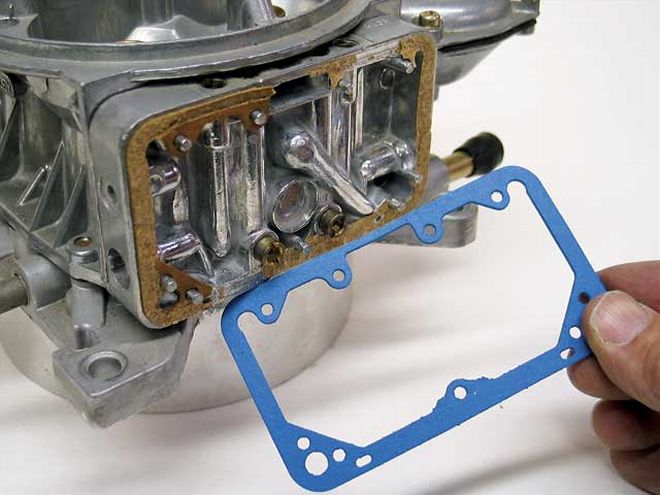
Gasket Tech
Holley has recently switched to the blue bowl and metering-block gasketsthat don't stick and tear like the old gaskets. You can buy themseparately in packages of two or as part of a rebuild kit.
Whoa Control
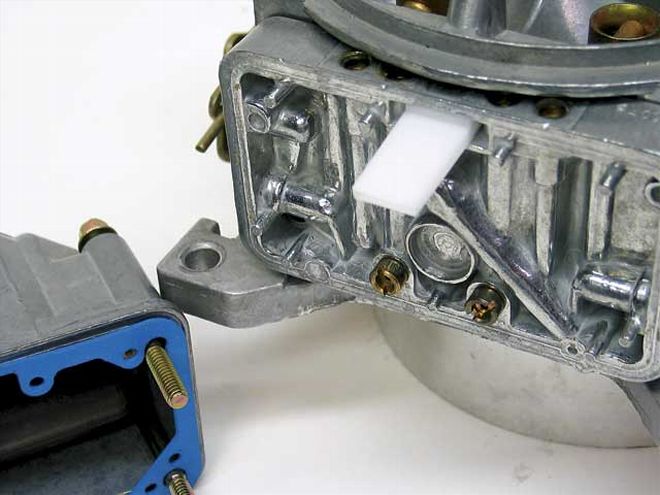
Ever stomped on the brakes real hard only to have your Holley-carb'dengine stumble and die? When you're stuck in the middle of anintersection with a gravel truck headed your way, it's no time to havethis happen! This sometimes occurs when fuel from the secondary bowlsloshes forward, shoots out of the secondary vent tube, and floods theengine--stalling it. Drag racers often place a length of gas line overboth vents, but the cleaner approach is to use a vent whistle. Thesewhistles are often discarded during rebuilds, but the good news is thatby ordering PN 26-40, you'll get a 2-inch whistle for a mere $7 fromSummit that will solve that problem.
Check WOT
Check what? A simple test that could be worth 10 hp is to merely checkto make sure your carb linkage actually achieves wide open throttle(WOT). Have your buddy jump in the car, and with the engine off (do wehave to tell you that?), have him hit the throttle while you make surethe carb opens fully. In addition, for older musclecars with solidlinkage, you could make a slick link with spherical rod ends at eitherend for more precise operation.
Warp Factor
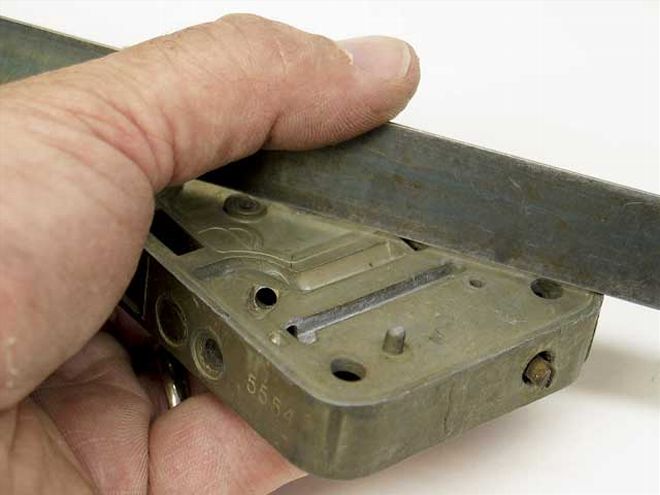
One common problem with Holley carbs is gorilla-fingered tuners.Overtightening the bowl screws will often warp the metering block,creating a vacuum leak that is difficult to diagnose. The easy way tocheck this is by placing a straightedge across the metering-block face.If you see light, the block will need to be milled, which should be leftto a professional carb rebuilding company like The Carb Shop(www.customcarbs.com).
Pressure Tactics
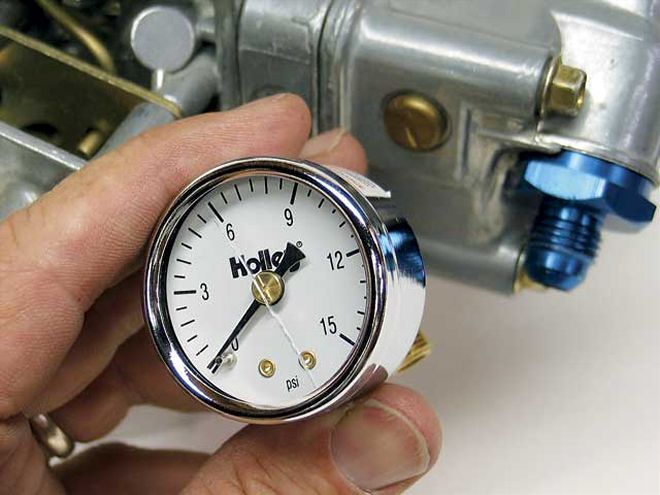
Fuel pressure is a key element to ensure solid engine performance.Holley makes a small fuel-pressure gauge (PN 26-500, $24) designed toplug directly into the fuel line at the carb. You could also rig up alength of copper line and place the gauge up on the cowl temporarily tocheck fuel pressure at WOT. The fuel pump is taxed most heavily at thetop of high gear on a full-throttle dragstrip pass. Make sure you haveat least 4 to 5 psi of fuel pressure at that point. If not, startlooking at improving your fuel delivery system.
Details
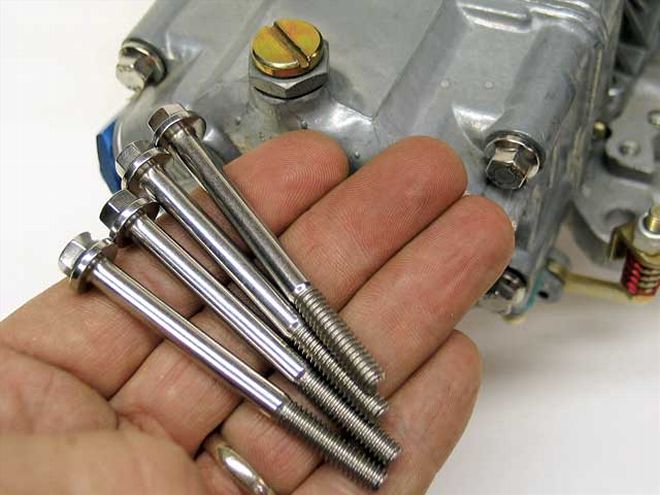
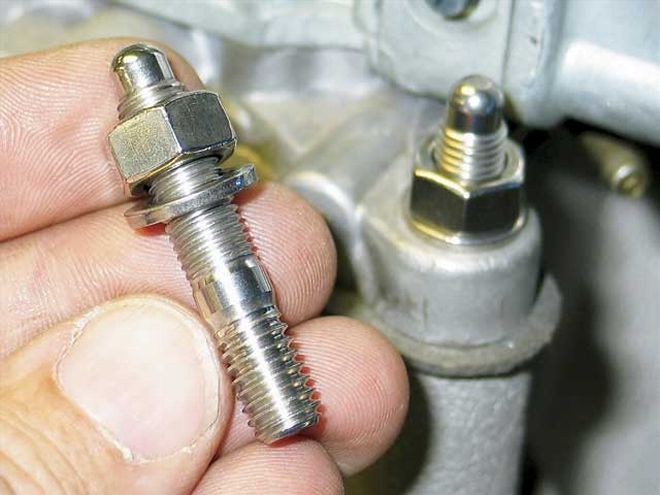
Speaking of bowl screws, ARP offers stainless steel bowl-screw fastenersfor 4150-style Holley carbs (PN 400-0310) and shorter screws for therear bowls on 4160 Holleys (PN 400-0311, $24). You can pick up eitherkit from Summit and add a little sparkle to your favorite fuel mixer.Or, if you prefer more practicality, ARP offers several types ofstainless carb-stud kits as well. The standard kit is shown here (PN400-2401, $16) and you can also pick up a stainless air-cleaner stud andnut (5/16 x 2.7 inches, PN 400-0302, $8).
Idle Speed Deeds
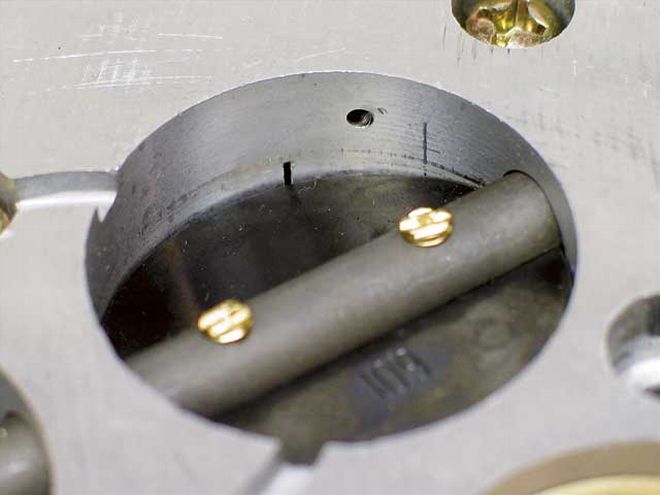
Big cams and low idle vacuum can make for an off-idle stumble that'soften tough to cure. The problem stems from cranking the primarythrottle blades open too far, which uncovers too much of theidle-transfer slot (arrow). When you lightly step on the throttle, theengine stumbles or sneezes because there's no additional fuel availableto help accelerate the car, since the transition slot is already in use.The trick is to close the primary throttle blades down to where thetransition slot is barely uncovered.
This step will create a too-low idle speed. One way to help that is tocrack open the secondary idle stop (located on the bottom of mostHolleys on the passenger side) a half-turn or so. If that doesn't help,you might try adding a PCV valve to the carb, which is also a calibratedair leak that will add a little speed. If all those tricks still don'thelp, you will have to resort to drilling a small hole in each primarythrottle blade on the leading edge. Start with a 1/8-inch hole in eachprimary throttle blade and work up one size at a time. It's a slowprocess, but that's the best cure for the big-cam off-idle stumble.
Cams for Carbs
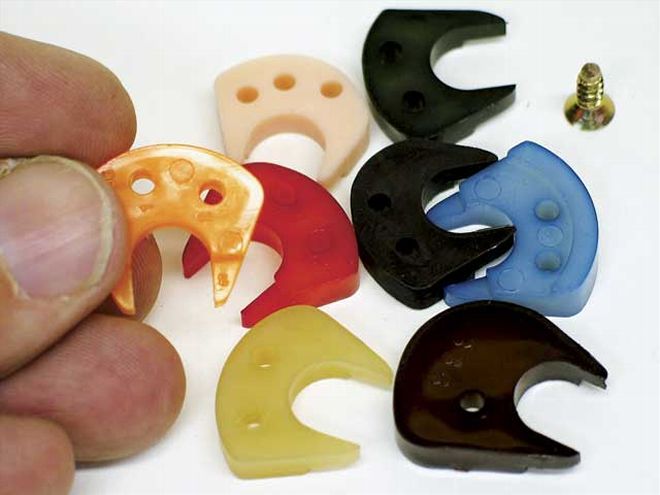
Most Holley four-barrel carbs use a typical accelerator-pump cam andsquirter combination that generally works very well. If you're intoexperimenting to improve your dragstrip 60-foot times, you mightconsider investing in an accelerator-pump cam assortment kit (PN 20-12,$20) that will allow you to tailor the pump-shot fuel deliverycurve--basically either more quickly or more slowly. Shoot for addingthe amount of pump shot that will accelerate your car the quickest. Youcan also work with accelerator-pump squirter size to trim the amount andrate of delivery.
Leak Detecting
An engine tuner once told us that 90 percent of all driveabilityproblems could be traced to vacuum leaks. If your street motor issuffering from part-throttle hiccups or the lean-surge blues, take a fewminutes to search for a vacuum leak, first make sure all the carb andintake-manifold bolts are tight. Also make sure all the vacuum outletson the engine are closed off and that all vacuum lines are intact. It'scommon to discover a rubber vacuum plug is missing or cracked. Ifeverything is secure, start the engine, warm it up, and shoot shortsquirts of WD-40 around the intake and the carb and listen for a changein idle speed. If you locate an area where the engine speed increaseswhen you hit it with WD-40, then you've found a vacuum leak. The enginespeed increases because the leak pulls the WD-40 into the engine andburns it, temporarily increasing engine speed. This can make a mess thatwill have to be cleaned, but it works to locate hard-to-find vacuumleaks.
PV Prevention
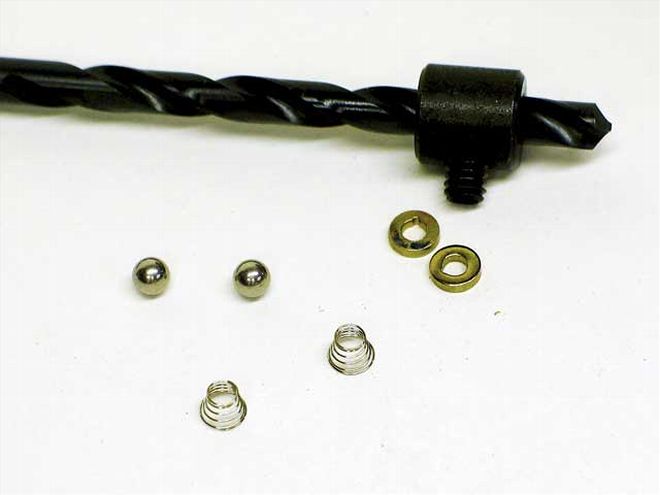
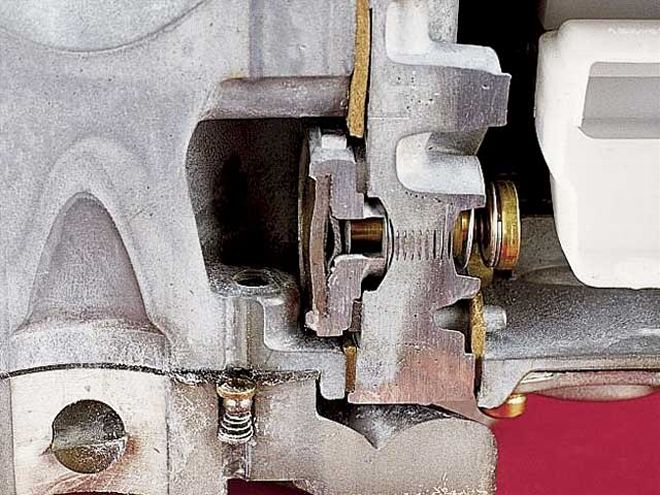
A common knock on older Holleys was their easily blown-out power valves.Holley addressed this and made them much more durable. The company alsosells a power-valve check-ball kit (PN 125-500, $13) for all pre-'922300-, 4160-, and 4150-style carbs. The kit positions a small checkball, spring, and brass seat in the passage leading to the power valve.In the event of an engine sneeze, the check ball quickly closes,preventing pressure from damaging the power valve. All new Holley carbscome with this as a built-in feature.
Edelbrock Performer
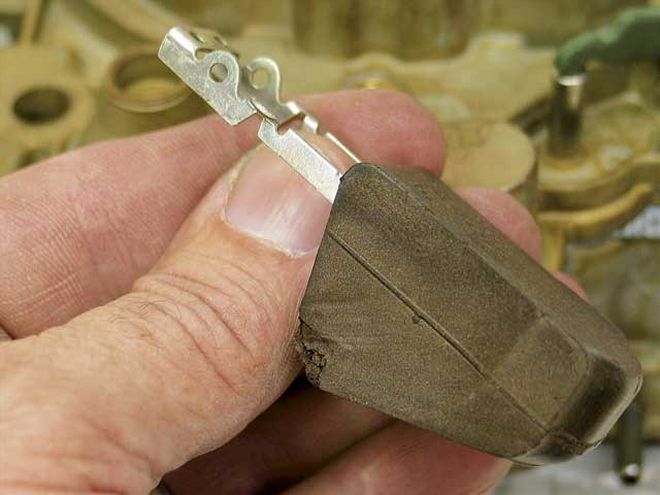
Primary Jetting
The beauty of the Edelbrock Performer series carburetor is that you canchange the primary metering rods and springs without having to removethe carburetor lid. Using a small, straight screwdriver, loosen thescrew and slide the cover over to allow the primary piston and meteringrod to pop out. The Edelbrock carb uses a primary-jet and metering-rodcombination along with the step-up spring. Manifold vacuum drops as thethrottle is opened, and the step-up spring pushes the metering rod outof the jet, increasing fuel flow. You can fine-tune your engine byexperimenting with leaner or richer metering rods and also with variousstep-up springs.
Q-Jets
Floats That Don't

One of the innovations applied to Q-jets in the '70s was a move to aplastic or nitrophyl float. These floats are easier to make, butunfortunately over time they have a tendency to absorb fuel, so after awhile the float is more like a sinker. The fix is to replace your oldfloat with a new one, like a direct replacement float from Edelbrock (PN1985 or 1985, $10). Also make sure to properly set the float level. Thisis a critical adjustment for all Q-jets.
Open the Door
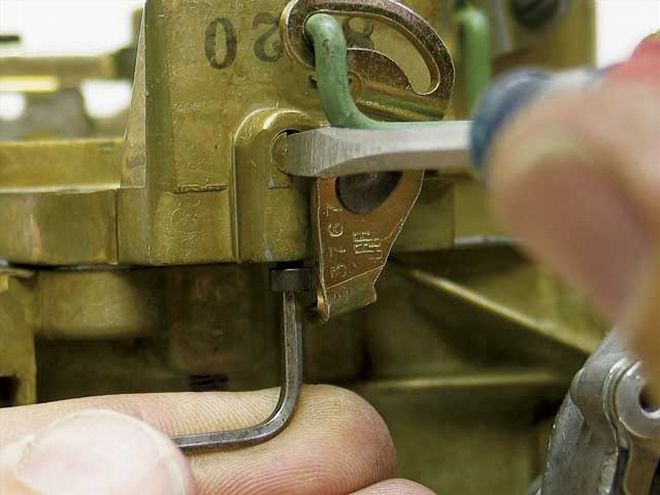
Q-jets don't use secondary accelerator pumps, yet they sport amechanical- secondary operation. The key to making the secondaries workis the spring-loaded secondary air valve. Once you hit WOT, air rushingthrough the primaries hits the air valve and overcomes the springtension to eventually push the air valve open. You can adjust the springtension by loosening the locking Allen screw on the rear passenger sideof the carb and then adjusting the spring tension with a small straightscrewdriver. Loosening the tension will open the valve sooner, but tooloose and the engine will hesitate or bog when you mash the throttle. Toset this properly, reduce the air-valve spring tension until you feel ahesitation on hard acceleration. Then tighten the tension until thetransition to WOT is seamless.
Just Hangin'
If you watch how the air valve operates, you'll notice that a hangersits on an eccentric that lifts the hanger as the air valve opens. Thishanger supports the main metering rods. As the air valve opens, thehanger pulls the metering rods out of the fixed orifices. To fine-tunethe position of the metering rods in those fixed orifices, differenthangers can be used. Edelbrock offers hangers in five height sizes, andits spec defines the distance from the hole to the top of the hanger.The larger the distance, the less the hanger will pull the secondarymetering rods out of the fixed orifice. The B hanger will yank the rodsout the most, and the V hanger will pull the rods out the least as theair valve opens.
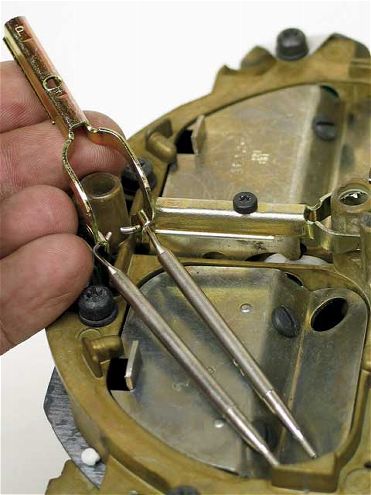
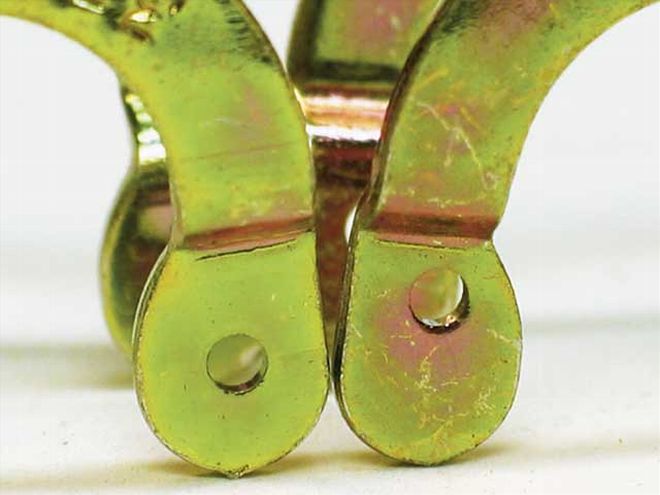
The secondary metering rods taper down to a power-tip diameter spec'd inthe accompanying box. The larger the power-tip diameter, the leaner themixture because it displaces more area in the fixed orifice in the carbbody. Therefore, the CC rods will produce the richest air/fuel ratiowhile the CL rods will create the leanest mixture. Changing secondarymetering rods in a Q-jet is incredibly simple--just remove the hangerand pull it out with the rods.
Book Review
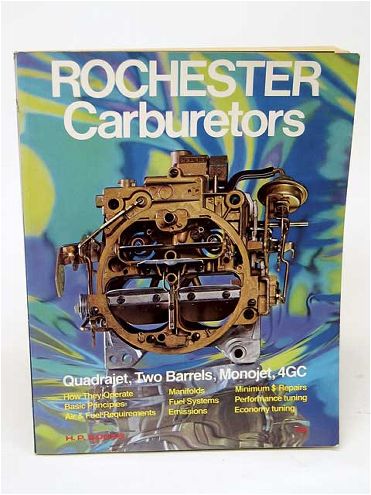
The Q-jet has a reputation for being somewhat complex. But if you workwith it awhile, you'll learn that it's not that difficult. If you'd liketo learn more about this very streetable and flexible carburetor, thebest place to start is with H.P. Books' Rochester Carburetors by DougRoe and Bill Fisher. The book is filled with rebuilding tips andinvaluable tuning advice that will make you a Q-jet expert in no time.
Rod Arrangement
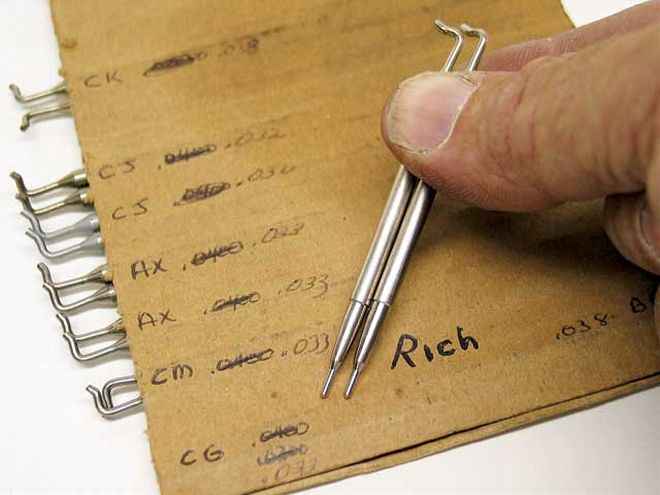
We learned this trick from Edelbrock's Kurt Hooker many years ago. Tomake his large collection of Q-jet metering rods quickly accessible,Kurt slides them into a rectangular piece of cardboard, from rich tolean, marking their stampings on the cardboard. This makes them easy tofind when he needs metering rods.
Leak Repair
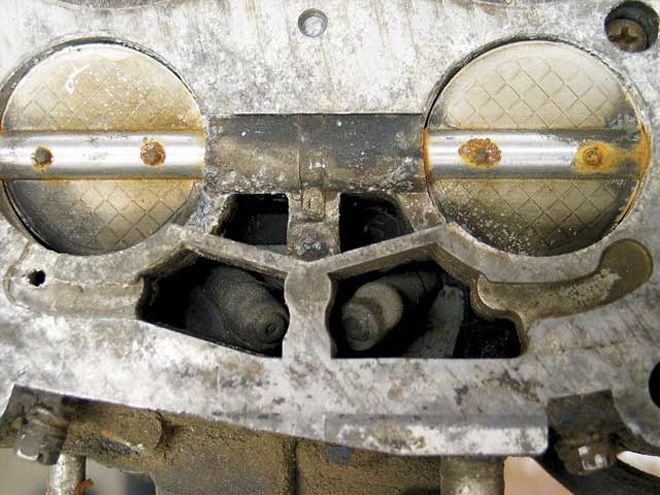
A common ailment with older Q-jets is leaking from drilled and plugged orifices in the bottom of the main carb body. The quick fix is to thoroughly clean the areas shown in the photo and then mix up some two-part epoxy or JB Weld and coat them thoroughly. This will prevent fuel from leaking into the intake manifold. Keep in mind that even with this modification, older original Q-jets have a problem with porosity that allows fuel to leak out of the bowl through the casting. When that happens, it's time to replace it with a new carburetor.
Demon
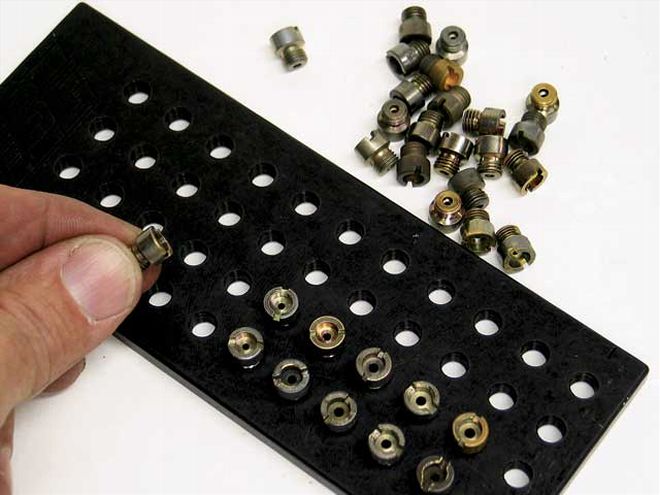
Beat the Heat
One way to keep manifold heat away from your carb is with one ofEdelbrock's heat insulator gaskets. This particular gasket (PN 9265) is0.320-inch thick and is intended for the Edelbrock Performer seriescarburetors, but it will also work with Holley and Demon carbs. Theinsulator gasket is only $14 through Summit and does a good job of notcooking the fuel in the carb during long bouts of low-speed cruising.
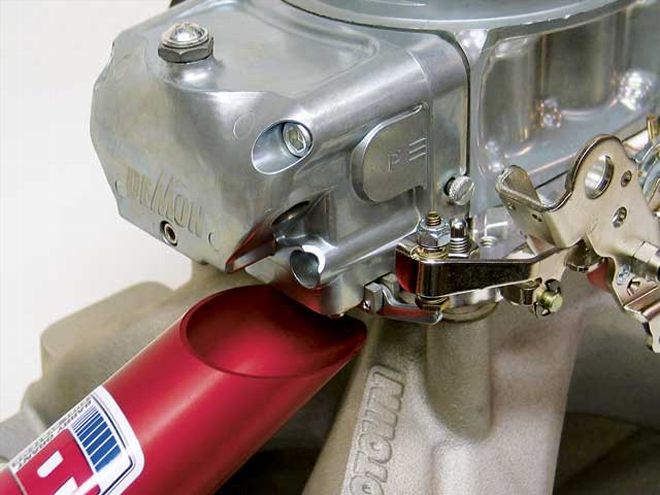
Main Drain
If you're into making horsepower and tuning, then changing jets isprobably as common an occurrence as breathing. For Demon carbs, likeHolleys, the trick is to drain the fuel out of the bowl so it doesn'tend up all over your intake manifold. Barry Grant offers a cool aluminumfloat bowl catch can (PN 130040, $15) that can do the job and make youlook like a professional all at the same time.

Jet Plate Special
Speaking of jetting and looking like you know what you're doing, we'veall seen those guys at the track with plastic Tupperware they stole fromtheir wife's kitchen stuffed full of jets. Then they spend a half-hourlooking for a matching pair of jets-- not cool. Rather than waste allthat time, get yourself a jet plate from Barry Grant (PN 130001, $15)that will mount up to 44 jets that you can screw into the plate inascending order so that you'll always have your jets handy when you needthem.
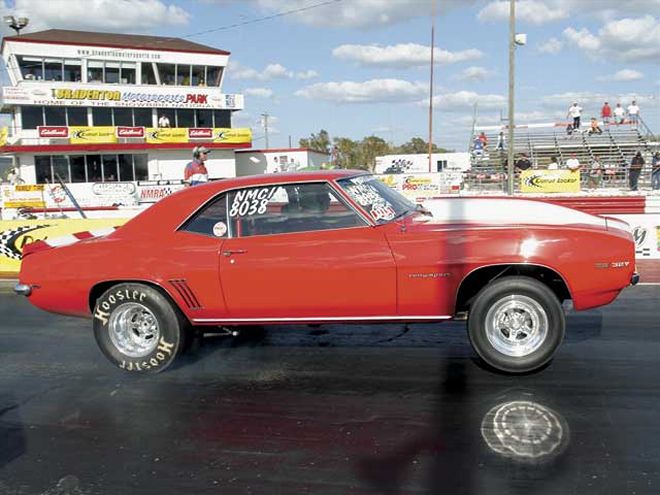
Blocking Maneuver
Have you ever wondered why it's not a good idea to run a power valve inthe secondary side of a BG or Holley carb? On a fast street or drag-carlaunch, the fuel in the secondary bowl is pushed to the rear of thebowl. Since the power valve is located higher in the bowl than the jets,it is easily uncovered and might not richen the mixture when you need itmost. That's why if the secondary metering block is equipped with apower-valve fitting, it's best to use a power valve plug on thesecondary side and tune that end of the carb with jets.
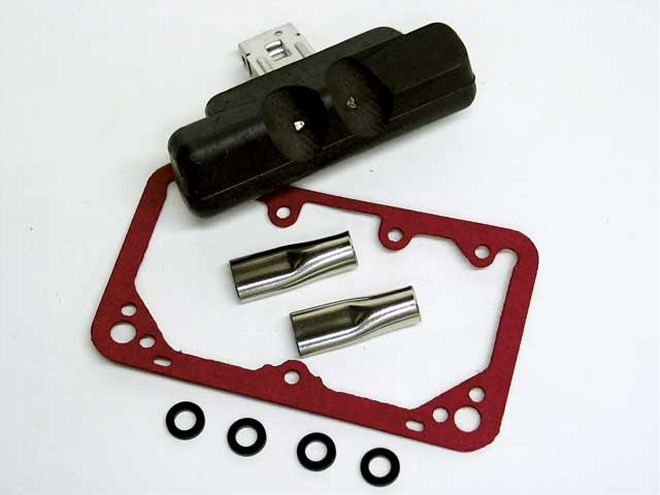
Jet Extensions
If you've got a hot streeter or drag car that launches hard, fuel willslosh to the rear of the secondary bowl and away from the main jets. Tocounteract this, jet extensions will often keep the fuel in contact withthe jets. Barry Grant offers a kit that includes a pair offlattened-style jet extensions that will clear a stock float. Also inthe kit is a bowl gasket and four bowl screw gaskets (PN 120001, $14).We've seen street cars gain 0.20 second with just the addition of jetextensions! BG also offers a clearanced float with cut-outs to clear anon-flattened jet extension (PN 120004, $16) that works well too.